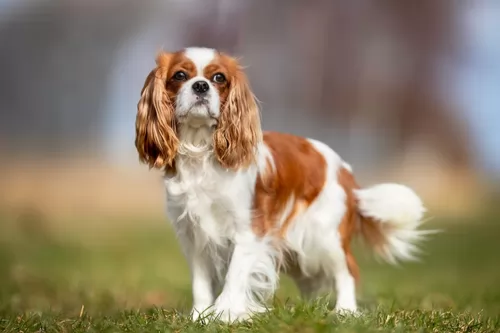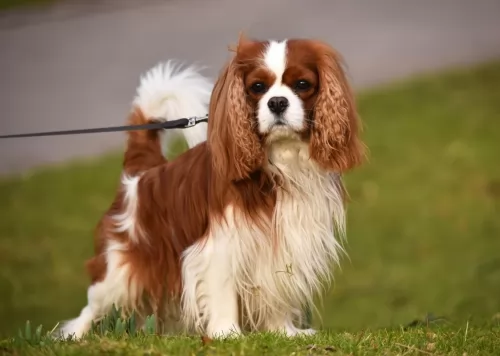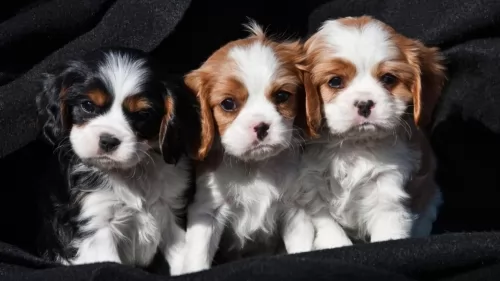 Petzlover
Petzlover Both Bloodhound and King Charles Spaniel are originated from United Kingdom. Bloodhound may grow 26 cm / 11 inches higher than King Charles Spaniel. Bloodhound may weigh 64 kg / 142 pounds more than King Charles Spaniel. Bloodhound may live 8 years less than King Charles Spaniel. Bloodhound may have more litter size than King Charles Spaniel. Bloodhound requires Low Maintenance. But King Charles Spaniel requires Moderate Maintenance
Both Bloodhound and King Charles Spaniel are originated from United Kingdom. Bloodhound may grow 26 cm / 11 inches higher than King Charles Spaniel. Bloodhound may weigh 64 kg / 142 pounds more than King Charles Spaniel. Bloodhound may live 8 years less than King Charles Spaniel. Bloodhound may have more litter size than King Charles Spaniel. Bloodhound requires Low Maintenance. But King Charles Spaniel requires Moderate Maintenance
 The history of the Bloodhound breed is a fascinating one. Known as a Sleuthhound for its ability to smell out the culprit and bag the prey. Even more so the Bloodhound is known for tracking and finding lost people. He is famous for finding human scents and being able to follow them even days or weeks after the person is lost. They are also able to track people over a great amount of land and have been known to successfully track escaped prisoners or wanted criminals. They are descended from the Saint-Hubert Hounds that were bred at the Abbey/Monastery at Saint-Hubert, Belgium. According to the legends the St. Hubert hounds were bred by the Monks in 1000AD. This hound was thought to be a mixed breed rather than a purebred. That’s because the ancestry of this hound is not really known but it is known that the monks bred them and sent several to the King of France annually. Only black hounds were gifted.
The history of the Bloodhound breed is a fascinating one. Known as a Sleuthhound for its ability to smell out the culprit and bag the prey. Even more so the Bloodhound is known for tracking and finding lost people. He is famous for finding human scents and being able to follow them even days or weeks after the person is lost. They are also able to track people over a great amount of land and have been known to successfully track escaped prisoners or wanted criminals. They are descended from the Saint-Hubert Hounds that were bred at the Abbey/Monastery at Saint-Hubert, Belgium. According to the legends the St. Hubert hounds were bred by the Monks in 1000AD. This hound was thought to be a mixed breed rather than a purebred. That’s because the ancestry of this hound is not really known but it is known that the monks bred them and sent several to the King of France annually. Only black hounds were gifted.
Some kings preferred not to hunt with these hounds thinking them not good enough while others thought the only use for them was as a leash hound. All described the St. Hubert as long in body with short legs. These gifts continued until the French Revolution when hunting in France was greatly reduced until the 19th century. The original St. Hubert strain became extinct in the 19th century and that the current European St. Hubert hound has its origins in the Bloodhound. The Bloodhound as a separate breed was already established in Europe by the middle of the 14th century. They were used as leach hounds to sniff out the prey so that the pack hounds could chase and keep it “at bay”. They were also used from the beginnings of the breed to track humans. At this time they were often known as sleuth hounds. As recorded by John Caius – the authority on Bloodhounds from their origins – writes about the breeds ability to find and track the scent of blood – thus becoming the Bloodhound and its use to track poachers and thieves. He also reported that the Bloodhound and the Sleuth Hound were the same basic breed. The number of Bloodhounds in Britain gradually declined until few remained after World War II. Britain has gradually built their breed back up by importing dogs from America. It was during the 19th century that the Bloodhound was imported into France by breeders who wished to reestablish the St. Hubert Hound. Thus the St. Hubert is both the ancestor and descendent of the Bloodhound. The Britain’s continue to believe that the Bloodhound is a native British breed.
The Bloodhounds in America have had great success as companion animals, with police departments and forest rangers and showing in the prestigious Westminster Kennel Club in New York. There are more Bloodhounds in the United States than anywhere else in the world.
In the end the Anglo-Saxton Bloodhound cannot be specified with any real certainty. Many believe it was not the St. Hubert that the Bloodhound descended from but rather the Norman hound or the sleuth-hound. Many believe it could have included other breeds such as the southern hound, the dun-hound and the Talbot. It cannot be proven today it the Bloodhound’s origins come from Belgian or England.
 Classified as a toy breed, the King Charles Spaniel is a small, pure breed dog that originated in the United Kingdom. The dog was named after King Charles II of Britain.
Classified as a toy breed, the King Charles Spaniel is a small, pure breed dog that originated in the United Kingdom. The dog was named after King Charles II of Britain.
The dog actually has quite a long, illustrious history. People mistake them for the Cavalier King Charles Spaniel, but they are 2 different breeds, just sharing the same coat colors.The King Charles Spaniel was crossbred with the Pug early in the 19th century to shorten the length of the dog's nose.
With a face similar to that of the Pug, it is thought that these toy spaniels may have originated in the Far East.The earliest recorded pictures of toy spaniels in England were in paintings of Queen Mary 1 and King Philip.
 When being judged for confirmation in a show ring, the preference is for a larger dog, with an unusual skeleton in respect to its large size and heavy weight in the bones. They have a narrow head, flat at the sides, but long. They have deep set eyes buried in the deep, long face and wrinkles. The eyes might be yellow or run the gamut to deep hazel depending upon the color of the dog. The long velvety ears and thin and low set on the head. These long ears are as much a part of the Bloodhounds Olfactory system as his amazing nose. They curl backward and inward as the ends. There is a large amount of loose skin on the head and at the jowls. When the Bloodhound lowers his head the loose folds and ridges of skin are prominent on the face and forehead.
When being judged for confirmation in a show ring, the preference is for a larger dog, with an unusual skeleton in respect to its large size and heavy weight in the bones. They have a narrow head, flat at the sides, but long. They have deep set eyes buried in the deep, long face and wrinkles. The eyes might be yellow or run the gamut to deep hazel depending upon the color of the dog. The long velvety ears and thin and low set on the head. These long ears are as much a part of the Bloodhounds Olfactory system as his amazing nose. They curl backward and inward as the ends. There is a large amount of loose skin on the head and at the jowls. When the Bloodhound lowers his head the loose folds and ridges of skin are prominent on the face and forehead.
For many centuries all different colors of Bloodhounds could be found. Today however they are pretty much red, black and tan and black and liver. The Bloodhound is a powerful dog and is larger than most breeds of hounds.
 The King Charles Spaniel is a medium sized dog that stands at roughly 23 – 28cm and weighs anything from 3 to 8kg. He is smaller than the Cavalier King Charles.
The King Charles Spaniel is a medium sized dog that stands at roughly 23 – 28cm and weighs anything from 3 to 8kg. He is smaller than the Cavalier King Charles.
He has a long coat which can be white, black and tan or a reddish-brown color. He has a domed head with a short, turned up nose and 'squashed' face similar to the pug. The eyes are large and dark and also protruding. The ears are set low and are long and floppy and the tail, once docked, is now left long and feathery.
Friendly, while being somewhat reserved, the King Charles Spaniel is looked upon as a lap dog as he loves to spend time indoors with his human family.
He isn't particularly energetic, but will still need some exercise like ball games and going on a walk. With training and socialization he becomes quiet and obedient and is known as a popular therapy dog. They are kind and loving with kids and pets in the home.
 The Bloodhound is known as a gentle soul and he truly is. They are affectionate and gentle with people and children. However, their strong will to track can make them stubborn and hard to handle and train. They are easy going dogs and really like to be with people, children and other dogs. They are affectionate but tend to be set in their ways.
The Bloodhound is known as a gentle soul and he truly is. They are affectionate and gentle with people and children. However, their strong will to track can make them stubborn and hard to handle and train. They are easy going dogs and really like to be with people, children and other dogs. They are affectionate but tend to be set in their ways.
 Your King Charles Spaniel is such a joy to have in the home and because he is intelligent he will easily learn some simple commands too.
Your King Charles Spaniel is such a joy to have in the home and because he is intelligent he will easily learn some simple commands too.
He wants to please you and be with you wherever you go. He is a social dog and thrives on your attention, and if you open your home and your heart to this sweet dog, you’re going to have a devoted, loving, loyal friend beside you every day.
 Obviously with ears like the Bloodhound there is always a chance for problems and serious infections. The ears need to be cleaned daily. Because their coat is so thick, they can overheat easily, and they are very prone to bloat, as are many large animals. However, with the Bloodhound, Bloat is the number one killer. Their lifespan is one of the shortest of all dogs at 6.75 years.
Obviously with ears like the Bloodhound there is always a chance for problems and serious infections. The ears need to be cleaned daily. Because their coat is so thick, they can overheat easily, and they are very prone to bloat, as are many large animals. However, with the Bloodhound, Bloat is the number one killer. Their lifespan is one of the shortest of all dogs at 6.75 years.
 The eye problems that you might need to know about with a King Charles Spaniel are entropian, cataracts and corneal dystrophy.
The eye problems that you might need to know about with a King Charles Spaniel are entropian, cataracts and corneal dystrophy.
Heart conditions could include mitral valve disease where the blood flows backwards through the chambers of the heart, leading to congestive heart failure.
The King Charles Spaniel is a brachycephalic breed and these dogs can have upper airway problems. Breathing difficulties can also occur because of an abnormally small windpipe which is a characteristic common to brachycephalic breeds. You may notice rapid breathing with your dog , snoring, frequent panting, coughing and difficulty with swallowing.
As a dog owner, you have a responsibility to your pet. He will need to visit the veterinarian for all his puppy vaccinations as well as other vaccinations as an adult dog. He will also need to be de-wormed.
If you don’t want him or her becoming a parent, make sure your pet is neutered or spayed. If your pet is showing signs of an illness that he doesn’t get over quickly, get him immediately to the vet.
 The Bloodhound is not a high energy, fast moving dog but that does not mean he doesn’t have serious nutritional needs. An overweight Bloodhound is on a course to an early demise. They should be fed a high-quality food once a day or split into two daily servings. Do not feed them right before or right after strenuous exercise and remember that strenuous exercise for a Bloodhound is considerably less than it is for a terrier.
The Bloodhound is not a high energy, fast moving dog but that does not mean he doesn’t have serious nutritional needs. An overweight Bloodhound is on a course to an early demise. They should be fed a high-quality food once a day or split into two daily servings. Do not feed them right before or right after strenuous exercise and remember that strenuous exercise for a Bloodhound is considerably less than it is for a terrier.
As previously mentioned the number one cause of death in Bloodhounds is Bloat. They are also prone to cancer. They have minor issues with their eyes, but their ears and skin are also major concerns. Clean the ears daily and wipe out the skin folds and wrinkles to prevent infections. They should be test for hip and elbow dysplasia simply because they are large dogs, though these conditions are less common in Bloodhounds.
Though the Bloodhound is known as a couch potato his stamina and activity levels are usually greatly underestimated. He can follow a scent for 7-10 hours over miles of terrain with out a problem. He needs daily exercise such as long walks on a leash. Do not take your Bloodhound out off leash because if he picks up a scent and wanders off you will not be able to get his attention to call him back.
 Your King Charles Spaniel has a long, silky coat that will require brushing twice a week to control shedding and keep his coat free of matting.
Your King Charles Spaniel has a long, silky coat that will require brushing twice a week to control shedding and keep his coat free of matting.
His nails will also require regular trimming to ensure they don’t hook on anything. His long ears are also prone to ear infection, so be sure to check them inside and out for ticks and fleas and to also remove excess wax and dirt.
Teeth should also be regularly brushed with canine toothbrush and toothpaste.
Be sure to keep your King Charles Spaniel content and healthy by ensuring he goes on a long walk and that you play with him to build a strong bond between you and to ensure he doesn’t become bored.
Excellent, quality food is important for your spaniel. The best dog food manufacturers have age- and breed-specific formulas and there is the perfect one for your King Charles Spaniel. Homemade food is also excellent for this dog and you can add some cooked chicken, brown rice and vegetables into his kibble as a nutritious treat.
Make sure your spaniel has a warm, dry, peaceful place to sleep and wash the bedding regularly to keep him healthy and happy.
Ensure he always has a cool, fresh bowl of drinking water nearby.